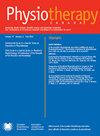Scoping Review: Brachial Plexus Birth Injury (BPBI) and Gross Motor Function
IF 0.8
4区 医学
Q4 REHABILITATION
引用次数: 0
Abstract
Purpose: Brachial plexus birth injury (BPBI) is a neonatal injury occurring in 1.24 in 1000 live births. The result of this injury on arm function is highly variable and has been the subject of many studies. However, the effect of BPBI on the development of overall gross motor function is less well studied. We aimed to synthesize the available literature on posture, balance and coordination, and gait in children with BPBI. Method: A scoping review was conducted by searching five databases (MEDLINE, EMBASE, CINAHL, PEDro, and Web of Science) and the grey literature for all study types related to our question. Studies unrelated to birth injuries, animal studies, and literature reviews were excluded. Three researchers independently screened the studies during two rounds of review (title/abstract and full-text). Results: Of the 2728 articles found, 16 articles were included. Overall, the average study quality was 0.90 out of 1.00. These studies suggest that observed postural deficits in BPBI are secondary to asymmetry rather than true scoliosis. Further, the asymmetrical nature of the injury results in both balance deficits and gait abnormalities when compared to healthy age-matched populations. Conclusions: The scoping review demonstrates that while there are obvious consequences to overall motor function and development in BPBI, these effects are likely under-studied. Further research should focus on understanding overall developmental differences in children with BPBI. Expanding on this information could possibly allow for earlier intervention, extended scope of physiotherapy, and better functional outcomes.范围综述:臂丛出生损伤(BPBI)和大运动功能
目的:臂丛新生儿损伤(Brachial plexus birth injury, BPBI)是一种新生儿损伤,发生率为千分之1.24。这种损伤对手臂功能的影响是高度可变的,已经成为许多研究的主题。然而,BPBI对整体大运动功能发展的影响研究较少。我们的目的是综合现有的关于BPBI儿童的姿势、平衡、协调和步态的文献。方法:通过检索5个数据库(MEDLINE、EMBASE、CINAHL、PEDro和Web of Science)和灰色文献对与我们问题相关的所有研究类型进行范围综述。排除了与出生损伤无关的研究、动物研究和文献综述。三名研究人员在两轮审查(标题/摘要和全文)中独立筛选研究。结果:在检索到的2728篇文献中,共纳入16篇。总体而言,平均研究质量为0.90分(满分1.00)。这些研究表明,BPBI中观察到的姿势缺陷是继发于不对称而不是真正的脊柱侧凸。此外,与年龄匹配的健康人群相比,损伤的不对称性导致平衡缺陷和步态异常。结论:范围审查表明,虽然BPBI对整体运动功能和发育有明显的影响,但这些影响可能尚未得到充分研究。进一步的研究应集中于了解BPBI患儿的整体发育差异。扩展这一信息可能允许早期干预,扩大物理治疗范围,以及更好的功能结果。
本文章由计算机程序翻译,如有差异,请以英文原文为准。
求助全文
约1分钟内获得全文
求助全文
来源期刊

Physiotherapy Canada
REHABILITATION-
CiteScore
1.90
自引率
20.00%
发文量
93
审稿时长
>12 weeks
期刊介绍:
Physiotherapy Canada is the official, scholarly, refereed journal of the Canadian Physiotherapy Association (CPA), giving direction to excellence in clinical science and reasoning, knowledge translation, therapeutic skills and patient-centred care.
Founded in 1923, Physiotherapy Canada meets the diverse needs of national and international readers and serves as a key repository of inquiries, evidence and advances in the practice of physiotherapy.
Physiotherapy Canada publishes the results of qualitative and quantitative research including systematic reviews, meta analyses, meta syntheses, public/health policy research, clinical practice guidelines, and case reports. Key messages, clinical commentaries, brief reports and book reviews support knowledge translation to clinical practice.
In addition to delivering authoritative, original scientific articles and reports of significant clinical studies, Physiotherapy Canada’s editorials and abstracts are presented in both English and French, expanding the journal’s reach nationally and internationally. Key messages form an integral part of each research article, providing a succinct summary for readers of all levels. This approach also allows readers to quickly get a feel for ‘what is already known’ and ‘what this study adds to’ the subject.
Clinician’s commentaries for key articles assist in bridging research and practice by discussing the article’s impact at the clinical level. The journal also features special themed series which bring readers up to date research supporting evidence-informed practice.
The Canadian Physiotherapy Association (CPA) is the national professional association representing almost 15,000 members distributed throughout all provinces and territories. CPA’s mission is to provide leadership and direction to the physiotherapy profession, foster excellence in practice, education and research, and promote high standards of health in Canada.
 求助内容:
求助内容: 应助结果提醒方式:
应助结果提醒方式:


